Cochamó Valley horse trekking - Meet the team

Caramor - sailing around the world
Franco Ferrero / Kath Mcnulty
Mon 5 Dec 2016 01:24
41:29.65S 72:18.31W Ciro Vivar - Chief Exec of 'Calbagatas Cochamó', International Guide, bi-lingual in Chilean and Inglishi,  Ida Delgado (not pictured) - the other half of 'Calbagatas Cochamó' who welcomed us warmly into her house and made sure we left heavier than we arrived Morro - The Horse Boss 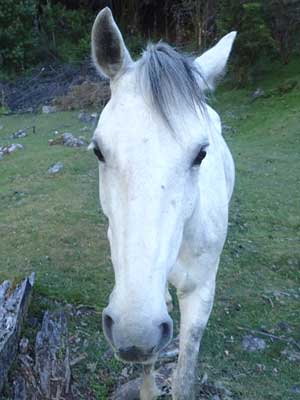 Grano de Oro - The big daft lad (with a heart of gold), as far as he is concerned he only has two legs (the front ones) 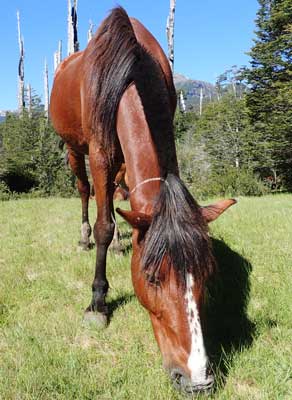 Estrella - the independent minded tight rope walker  La Gringa (because she is blond) - a tough little horse who carried the luggage and never complained 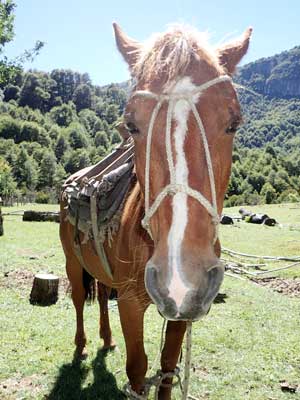 Franco Tirador - The 'Gaucho' ('franco tirador' means 'sniper' in Spanish and was Ciro's way of remembering Franco's name) 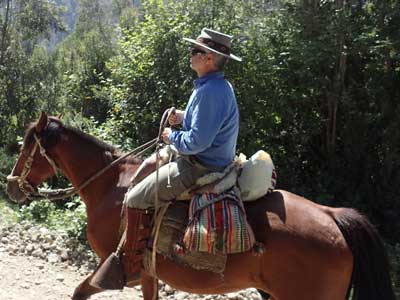 Yours truly - The Spanish Inquisition (because I never stop interrogating!)  Booking a nine day horse trek through rugged northern Patagonia was an act of faith, based on gut feeling. The last time we rode was in Uruguay, over a year ago and our buttocks ached in anticipation as I sent the confirmation email. We didn't know much about Ciro and Ida, only that Ciro looked like a proper Chilean cowboy and answered his emails regularly. His replies were brief, as if typed with one finger. We did know, however, that there were alerce trees (Fitzroya cupressoïdes) in the Cochamó Valley and were eager to see them. The alerce is a conifer which grows very slowly (1cm every 15-20 years) and can live 3-4,000 years. The trees can reach 50m high with a diameter of 3-4m. The timber is light weight, hard-wearing and doesn't rot. Its distribution is restricted to a narrow band of the Andes between Chiloe and Valdívia (39-43 south). Unfortunately the early colonists didn't realise its value or how slowly it grows and forests were often burnt to clear the land for agriculture. Standing trees are now protected and many of the areas where they grow have been given national park status. The bus left Puerto Montt at 12 noon so we ate our picnic on the bus. Two and a half hours later, we alighted outside the Cochamó police station and Ciro was waiting for us. As soon as we reached their alerce-clad house, looking out over the fiord with the Yate Volcano in the distance, Ida ushered us into the kitchen for a three course meal she had prepared for us; a nourishing noodle and meat soup followed by salmon, rice and a mixed salad with desert and coffee to finish off. We groaned and so did the horses in the field nearby. Cochamó is the most pleasant town we have visited so far in Chile. Its three thousand inhabitants are mostly involved in fishing and the salmon industry. Only a few make their living from farming and/or tourism. 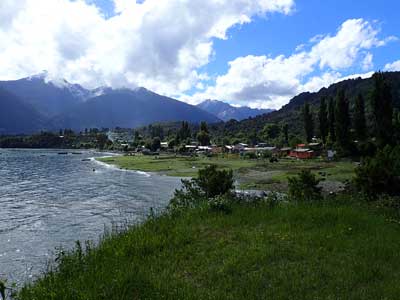 Cochamó  Ciro and Ida’s ranch and guest house 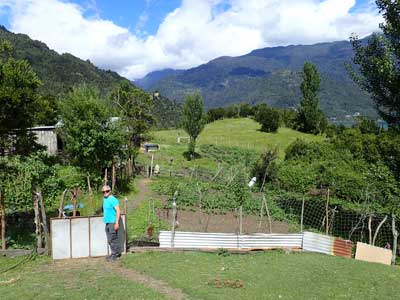 Ida’s veg plot (no slugs in Patagonia!) 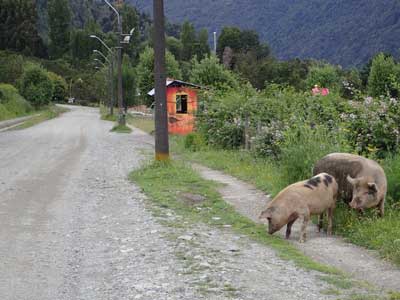 Pigs wandering the streets of Cochamó Franco and I took a walk to work off our double lunch and when we got back to the house, the table had been laid for 'once' (it means 'eleven' in Spanish and is a late afternoon snack which involves bread buns, cheese, pâté, jam and cake). At dusk, we were summoned back to the kitchen for another three course meal (soup, main, salad and cake). We barely managed to roll to our bedroom. We hoped we would be strong enough to haul our extra weight up onto the horses the next morning.  Volcán Yate - the view from Ida’s kitchen window |